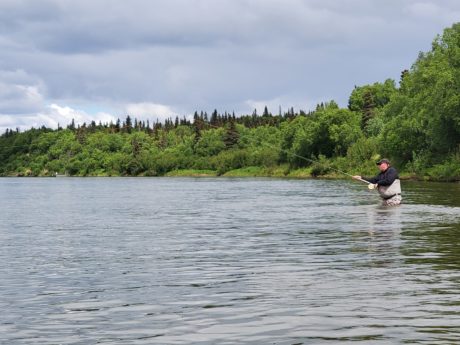
Today we continue our Alaska Guide Secrets series, in which you get the inside scoop direct from our guide crew at Alaska West.
You’ve decided which fly to fish and maybe even which sinktip to use. Now you need to decide whether your leader should be 2 feet, 6 feet, or 12 feet long. Got a headache yet? Spencer Dixon weighs in today with a great explanation of how to make that decision.
Long Leaders and Heavy Flies vs. Sinktips and Unweighted Flies
When approaching a run and trying to decide what sink-tip / fly/ leader length combination to fish, you should be thinking about a few things: water depth and speed, structure, and technique being used.
If you are swinging a lower river king run with consistent depth throughout, you want your fly to sink to the desired depth and stay there. A 10ft-15ft section of the sink tip matched appropriately to the water speed is just what you want. Make the cast, throw a good mend, and swing it out. Lighter flies and short leaders are the names of the game – let your sink tip do the work and reap the benefits.
On the other hand, if you are fishing a lower river seam or drop off, you want to cast and immediately have your fly sink to the desired depth. So a shorter section of sink tip (2.5-7ft) and a longer leader coupled with a heavy fly is what you’re after. You make the cast, you mend, and bang – you’ve dropped your fly right into the zone.
The same thing goes for trout fishing out of the boat – longer leaders and heavy flies apply. Your guide will be rowing and calling the shots, so when you cast to that juicy looking cut bank, your fly hits the water and immediately sinks to the fish’s level, and you’re in the game.
Sure, sink tips will work in this situation, but they will not sink as quickly as a heavy fly on a long leader. Sink tips are used to bring your fly to a certain depth and keep it there, but this is not always the fastest way to the feeding lane.
So next time you’re approaching a king of steelhead run, or getting ready to throw streamers for trout or dollies, ask yourself – slow and consistent, or quick and deep? And remember, mends are like relationships – a short good one is better than a long bad one.
Leave a Reply